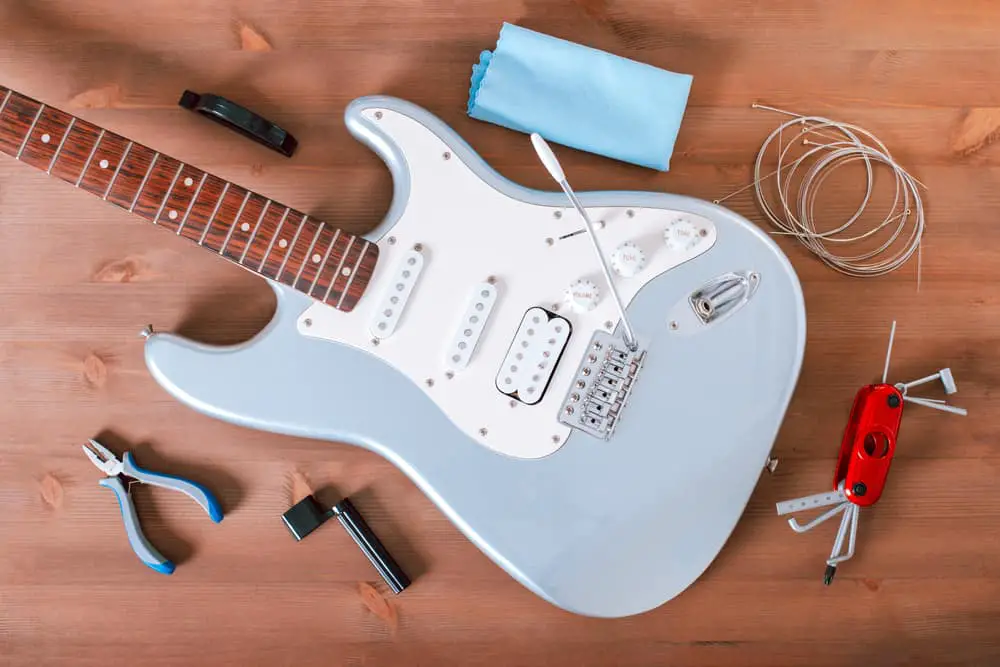
No matter how expensive your guitar is, the strings have to be changed at some point. The guitar is a fun instrument, but it needs maintenance like every other instrument. If you’ve been playing the guitar for quite some time, you must have had to restring your guitar at least once. However, it can come as a shock if you’re new to guitar. If you’ve reached this snag and need to replace your strings, there is no need to panic.
Restringing your guitar usually costs $5-$30 (this covers the cost of the strings). Having a professional do that for you can cost between $25 to $50 or the price of the strings plus $20 or more for the service.
If you can’t afford a professional, then you can restring it yourself. Let’s look at everything you need to know about guitar restringing.
When Should You Restring a Guitar?
Below are some signs that tell you when your guitar needs new strings.
String breakage: regular practice can cause the strings to break, and you can’t play with broken strings.
Discoloration: some bronze strings start to turn brown after extended use. Silver strings may also start looking discolored over time.
Wear and tear: if you notice your strings getting too loose even after tuning, it’s a sign to change them. Loose strings may signal impending breakage.
Unusual sound: if the strings start sounding wonky, it’s time for a change.
Rust underneath the strings: if you run your fingers underneath the strings and it’s rusty, you need to change the strings.
Tools You’ll Need to Restring a Guitar

So, you’ve taken it upon yourself to restring your guitar. Here are some tools you’ll need.
Strings
Needless to say, you’ll need a new pack of strings to restring your guitar—perhaps a few back-ups too. If you’re going to play guitar long-term, you should note that strings lose their life over time, so you’ll need to change them constantly. Most string packs cost $6 to $16.
If you need quality strings, you’ll pay more. Strings come in different gauges, so before you purchase strings, you should know what string gauge your guitar uses to find a pack that’s right for you.
String Cutters
Strings are held at the bridge and string posts on your guitar, so you have to loosen one side completely to remove the old strings. String cutters help you cut the strings and loosen them faster. You can get a string cutter for as low as $6. You don’t need it, but it can come in handy.
String Winder
Tightening the strings after you replace them can take some time and effort. This is where the string winder comes in. It helps you tighten the strings and get them in tune at a much faster rate.
Guitar Tuner
After fixing the new strings, you have to get your guitar back in tune. If you don’t want to purchase a guitar tuner, online tuners also work.
How to Restring a Guitar

Now that you have gathered the tools follow the steps below to restring your guitar by yourself.
1. Remove the Old Strings
Place your guitar on a flat surface—like the ground or a table (be careful not to scratch it). Next, reduce tension on the strings with the tuning peg. Once the strings are loose, you can start to clip them with a string cutter or continue turning the tuning peg until the strings can be removed manually from the holes.
On the bridge end, you can pull out each string. However, some guitars use bridge pins, which can make it more difficult. If it’s too much work, just clip the strings.
2. Install the New Strings
Look up how to install guitar strings, and you’ll find resources that will help you. After installation, turn the tuning pegs to tighten the strings. Use the wire cutter—or any clipping tool—to clip off excess strings that stick out.
3. Tune the Guitar
After successful installation. The last step is to tune your guitar, and you’re done.
Takeaway
Your best bet would be to enter your nearest guitar shop and have a professional restring your guitar. If you want to take matters into your hands, ensure you get the appropriate equipment and try not to damage your guitar.
Frequently Asked Questions
If any string snaps, you can replace it. However, the broken string can signify you should replace all the other strings. The replaced string will sound better than the other strings, and it can cause a difference in tone.
Guitarists should consider changing strings every 3 months. Of course, this is only a precautionary measure; your guitar strings may last twice as long.
Although it’s not advisable, you can safely remove all the strings at once. Ensure you loosen all the strings first so you won’t damage the guitar neck.









